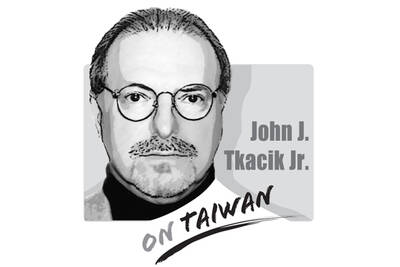As Ethiopia begins diverting 13.5 billion cubic meters of water from the Blue Nile River to its controversial new mega-dam, residents of Sudan to the south fear a repetition of last year’s devastating drought.
The second stage of filling the US$4.5 billion reservoir is ratcheting up tensions between Ethiopia and neighbors Sudan and Egypt, who depend on the Nile to support farming and generate power for their economies.
It is also altering decades of behavior by the river, which normally swells in July when seasonal rains come. It affects tens of millions of people living along the 6,650km-long Nile who rely on it for their water supply.

Illustration: Yusha
The move by Ethiopia to tap enough water to fill 5.4 million Olympic-size swimming pools was telegraphed for months. Yet it highlights how the many rounds of attempted mediation with Sudan and Egypt have failed, raising questions as to whether a solution can ever be found, or if Ethiopia will simply win by getting the dam filled in the meantime.
It also comes at a delicate time for the administration of Ethiopian Prime Minister Abiy Ahmed, who has a strong incentive to push ahead with the project and make good on his promises to rejuvenate an economy that is set to grow at a tepid 2 percent this year. While Abiy’s party leads the vote count in last month’s parliamentary elections, the Nobel Peace Prize laureate’s popularity has dropped from the levels he enjoyed when he first took office in 2018.
Meanwhile, his military has been embroiled in fighting in the northern breakaway region of Tigray for the past eight months, and his troops have also clashed with Sudanese soldiers in a disputed border region that contains a much-coveted fertile stretch of land.
None of the parties in the wrangling over the Grand Ethiopian Renaissance Dam (GERD) want the dispute to set off a broader war, but the more the dam becomes a reality, the greater the risk is that it bleeds into pre-existing military frictions.
For Amal Hassen and her family in the town of Roseires in Sudan, about 60km downriver from the Ethiopian border, the loss of water supply to their home last year was a clear signal that the dam project, with its 6,000-megawatt hydropower plant, spells disaster. She had to walk more than 1.6km to collect water in jerry cans from the river bank. Drinking that untreated water made her family sick.
“We tried to add chlorine to the river water so we could drink,” Hassen said at her home. “Every day, I would help the community to boil water.”
Ethiopia, Africa’s second-most populous nation, says the dam is needed to address chronic energy shortages and sustain its manufacturing industries; Sudan says filling the reservoir could hinder the southerly flow of water it requires to sustain its own electricity production and agriculture; and Egypt objects to a dam on a river that is the sole source of fresh water for as many as 100 million of its people.
As Abiy’s government moves ahead with the next stage of filling the dam, a diplomatic solution still looks elusive. That is despite many rounds of talks over a period of a decade, and the attempted mediation by the African Union. There have also been attempts to rope in the US, the UN and the EU to help navigate an agreement.
Egyptian Minister of Foreign Affairs Sameh Shoukry, in New York for a UN Security Council meeting on the issue last week, said that both his country and Sudan are committed to talks and a peaceful settlement.
Even so, “all options are on the table” when it comes to reaching that goal, he said in an interview with the pan-Arab satellite channel Arabiya.
Egypt has suggested that the dam be filled over a period of as long as 15 years, and it is pressing for guarantees that water will be released during times of drought.
The repercussion of the failure to conclude a treaty became evident on July 13 last year, when the dam gates were closed as heavy rains pounded the Ethiopian highlands and 5 billion cubic meters of water were collected in its reservoir. No warning was given to the Sudanese, who operate a much smaller dam of their own downstream in Roseires.
A monitoring station located at the border between Ethiopia and Sudan showed the Nile’s water level plummeted 100 million cubic meters between July 12 and 13, Sudanese government logs show. The last time they dropped that low was in 1984, the driest year on record.
Further downstream, six drinking water stations for the Sudanese capital, Khartoum, ran dry, leaving most of the city’s 5 million people without piped supplies for three days. Irrigation systems along the Nile’s banks stopped working, damaging crops.
Ethiopia’s unilateral actions prevented the Sudanese from adjusting water levels at the Roseires dam and a smaller reservoir on the White Nile River to compensate for the filling of the GERD, according to a Sudanese government document seen by Bloomberg.
Government officials, residents along the Blue Nile’s banks and hydrological experts interviewed by Bloomberg gave the same account of how the filling unfolded.
Ethiopian Minister of Water, Energy, Irrigation and Electricity Seleshi Bekele did not reply to questions.
He has stated publicly that there is a conspiracy to thwart Ethiopia’s sovereign right to fill the dam. He has also said water flows to Sudan and Egypt will never be interrupted, and filling the dam will reduce the risk of flooding in Sudan and the amount of sediment flowing downstream.
Flooding has been a perennial problem in the region. In August last year, hundreds of homes, an untold quantity of crops and entire sections of road were destroyed in Sudan’s Blue Nile, Sinnar and Al-Jazeera states after heavy rains fell over Ethiopia after a long drought.
Government contractors are still busy repairing the road and bridges between Khartoum and Roseires, while homes close to the Blue Nile’s banks are still being rebuilt.
Mustafa Hussein, the head of Sudan’s technical negotiating team on the dam, said Ethiopia could have minimized damage by gradually filling the GERD in August when the rainfall is heaviest, rather than retaining 5 billion cubic meters within a week in July.
Flooding and drought are not the only issues. In November last year, Ethiopia opened one of the GERD’s lower gates for 42 minutes, releasing 3 million cubic meters of water, according to a description of the event recounted in a letter Seleshi wrote to his Sudanese counterpart.
Minutes later, Sudan’s El Deim monitoring station, located just over the Ethiopian border, recorded a sudden rise in sediment flowing downstream. The heavy silt blocked four of the Roseires dam’s seven turbines, causing power outages that stretched as far as Khartoum, said its manager, Abdullah Ahmed.
While experts say Sudan is better prepared for this year’s filling of the GERD, and plans to retain more water in the Roseires dam to avoid a drought, there is little it can do to prepare for another flushing of sediment.
Water shortages remain Hassen’s main concern.
“We will not be happy if it happens again,” she said. “We pray the government protects us this year.”
A Chinese diplomat’s violent threat against Japanese Prime Minister Sanae Takaichi following her remarks on defending Taiwan marks a dangerous escalation in East Asian tensions, revealing Beijing’s growing intolerance for dissent and the fragility of regional diplomacy. Chinese Consul General in Osaka Xue Jian (薛劍) on Saturday posted a chilling message on X: “the dirty neck that sticks itself in must be cut off,” in reference to Takaichi’s remark to Japanese lawmakers that an attack on Taiwan could threaten Japan’s survival. The post, which was later deleted, was not an isolated outburst. Xue has also amplified other incendiary messages, including one suggesting
Chinese Consul General in Osaka Xue Jian (薛劍) on Saturday last week shared a news article on social media about Japanese Prime Minister Sanae Takaichi’s remarks on Taiwan, adding that “the dirty neck that sticks itself in must be cut off.” The previous day in the Japanese House of Representatives, Takaichi said that a Chinese attack on Taiwan could constitute “a situation threatening Japan’s survival,” a reference to a legal legal term introduced in 2015 that allows the prime minister to deploy the Japan Self-Defense Forces. The violent nature of Xue’s comments is notable in that it came from a diplomat,
Before 1945, the most widely spoken language in Taiwan was Tai-gi (also known as Taiwanese, Taiwanese Hokkien or Hoklo). However, due to almost a century of language repression policies, many Taiwanese believe that Tai-gi is at risk of disappearing. To understand this crisis, I interviewed academics and activists about Taiwan’s history of language repression, the major challenges of revitalizing Tai-gi and their policy recommendations. Although Taiwanese were pressured to speak Japanese when Taiwan became a Japanese colony in 1895, most managed to keep their heritage languages alive in their homes. However, starting in 1949, when the Chinese Nationalist Party (KMT) enacted martial law

“Si ambulat loquitur tetrissitatque sicut anas, anas est” is, in customary international law, the three-part test of anatine ambulation, articulation and tetrissitation. And it is essential to Taiwan’s existence. Apocryphally, it can be traced as far back as Suetonius (蘇埃托尼烏斯) in late first-century Rome. Alas, Suetonius was only talking about ducks (anas). But this self-evident principle was codified as a four-part test at the Montevideo Convention in 1934, to which the United States is a party. Article One: “The state as a person of international law should possess the following qualifications: a) a permanent population; b) a defined territory; c) government;